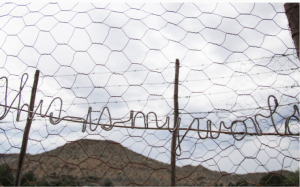Almost 20 years ago, before we had children, my wife and I took a road trip around South Africa. It’s a country of such exquisite beauty as well strange paradoxes. You can be driving in the middle of nowhere and you’ll suddenly see some lone soul wondering on the side of the road. You wonder, “Where might he be going?” or, “What brought him to such an isolated palace?” Potentially he too asked similar questions of us.
One of the places we stopped at was a dusty one street town called Nieu-Bethesda which has as its claim to fame the outsider art of the Owl House. The eerie and wonderful Owl House began its creation by Helen Martins in the late 1940’s, early 1950’s and was ultimately made famous by the playwright Athol Fugard in “The Road to Mecca”. The Owl House is South Africa’s finest example of outsider art and is testament to the enduring spirit of creative energies demanding an outlet.
Legend has it that Helen Martins lay ill in bed one night, the full moon was shining through her window, and she was plagued by thoughts of how dull and lifeless her world had become. She had returned to her home town of Nieu-Bethesda to nurse her ailing parents and after their passing her simple life in the small farming community of the Eastern Cape had narrowed itself into a very basic existence.
Apparently ‘Miss Helen’ as the community referred to her, resolved in her sick bed to bring light and colour into her life. She systematically set about embellishing her environment with patterns of brightly coloured glass, bottles, wire and cement figures that paid homage to her love of the East and the poetry of Omar Khayyam and William Blake.
She and her colleague Koos Malgas laboriously crushed glass through a large coffee grinder in the back yard which ‘Miss Helen’ then smeared and embedded into wet cement bringing a luminous beauty to her works. She began inside the house morphing it into a temple of light, colour and mystery. She then moved to the outdoors and envisioned a grand display of mystic proportions.
The procession of figures in the ‘Camel Yard’ is staged to follow the East and when ‘Miss Helen’ realised she had placed them in the wrong direction she simply created a sign pointing to her own idea of the East. She reinvented the direction of East and transformed her dusty garden into a wondrous arena of pyramids, sphinxes and pilgrims.
In the years that followed, Helen grew more and more estranged from the outside world. The community of Nieu-Bethesda grew cautious of the eccentric artist and she too of them. Eventually crippled by arthritis and going blind ‘Miss Helen’ killed herself by swallowing a mixture of caustic soda and ground up glass. It was a painful death.
On one of the fences in her garden ‘Miss Helen’ had bent out the statement, ‘This is my world’. The pilgrims moving towards their false East, the owls and camels and ziggurats of worship all glisten and gleam in the arid air and austere natural surroundings of Nieu-Bethesda. The whole home and garden is like a mirage in the middle of nowhere.
All art reveals its creator. Helen Martins spent the greater part of her life creating an alternate world around her that contrasted deeply with her disappointing daily reality. Her life may have been tough and filled with disillusion, but the life that emerged through her imagination was and is astonishing.
I wonder how many of us use our own lives to create something uniquely beautiful that represents how we want to see the world and how we want the world to see us. In fact isn’t this what each of strives to achieve in our own ways. To some extent we are all like ‘Miss Helen’ transmuting our reality into something as beautiful as we can make it.








Hi Cal. I’ve missed your stories. So pleased to read this new one!
Glad the stories are still hitting the mark!